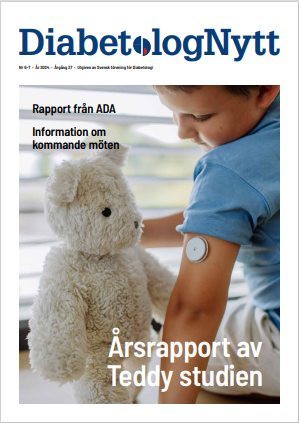– Vi blev väldigt förvånade att sambandet var så tydligt, så pass att vi gjorde om den statistiska analysen, säger Christina Dalman, professor i psykiatrisk epidemiologi vid Karolinska institutet och ansvarig för studien.
Eftersom det handlar om en observationsstudie så går det inte att säga om det är de studerade läkemedlen som påverkar patienternas psykiatriska mående. Det skulle kunna finnas andra orsaker till att perioder när patienterna hämtar ut läkemedel mot diabetes och hjärt-kärlsjukdom sammanfaller med perioder när de mår bättre.
Bakgrunden till att forskarna ville studera ett eventuellt samband grundar sig i att samtliga de studerade läkemedlen teoretiskt sett skulle kunna påverka det centrala nervsystemet.
– Tidigare forskning har visat att det finns inflammatoriska förändringar hos personer med allvarlig psykisk sjukdom. En av våra hypoteser var att statiner, som har en antiinflammatorisk effekt, skulle kunna påverka den psykiska sjukdomen, säger Christina Dalman.
Totalt analyserades data från omkring 142 000 svenska patienter med schizofreni, bipolär sjukdom eller icke-affektiv psykos.
Forskarna tittade på hur ofta patienterna var inlagda på sjukhus relaterat till den psykiatriska diagnosen, liksom i vilken utsträckning de utförde självskadande handlingar. Patienterna jämfördes med sig själva under perioder när de hämtat ut statiner, metformin eller kalciumflödeshämmare och perioder då de inte hämtat ut dessa läkemedel.
Enligt studien, som publiceras i Jama Psychiatry, kopplades behandling med läkemedlen bland annat till en halverad risk för individer med schizofreni att utföra en självskadande handling. Liknande tendenser syntes även för andra diagnoser och för sjukdomsinläggningar.
– En förklaring till skillnaderna skulle kunna vara att patienterna när de tar sina läkemedel mot andra sjukdomar mår bättre överlag. Men när vi tittade på vätskedrivande läkemedel, som enligt teorin inte påverkar centrala nervsystemet, såg vi inte någon skillnad med avseende på sjukhusinläggning eller självskadebeteende, säger Christina Dalman.
Hon säger att resultaten kan ha en klinisk relevans på så sätt att en läkare kan vara extra observant på om en psykiatrisk patient behöver läkemedel mot hjärt-kärlsjukdom och diabetes.
– Ofta finns en stor samsjuklighet och vi vet dessutom att andelen oupptäckta sjukdomstillstånd är högre bland personer med allvarlig psykiatrisk sjukdom. Kanske kan behandlingen göra nytta på flera sätt, säger hon.
Data i studien är från åren 2005 till 2016 och patienterna var alla över 15 år.
Läs mer i abstract och hela artikeln som pdf utan lösenord
Original Investigation
January 9, 2019
Association of Hydroxylmethyl Glutaryl Coenzyme A Reductase Inhibitors, L-Type Calcium Channel Antagonists, and Biguanides With Rates of Psychiatric Hospitalization and Self-Harm in Individuals With Serious Mental Illness
Joseph F. Hayes, PhD1; Andreas Lundin, PhD2; Susanne Wicks, PhD2; et alGlyn Lewis, PhD1; Ian C. K. Wong, PhD3,4; David P. J. Osborn, PhD1; Christina Dalman, PhD2
Author Affiliations Article Information
JAMA Psychiatry. Published online January 9, 2019. doi:10.1001/jamapsychiatry.2018.3907
Key Points
Question Are drugs in common use for physical health problems (hydroxylmethyl glutaryl coenzyme A reductase inhibitors, L-type calcium channel antagonists, and biguanides) associated with reduced rates of psychiatric hospitalization and self-harm in individuals with serious mental illness?
Findings In this series of within-individual cohort studies of 142 691 patients with bipolar disorder, schizophrenia, or nonaffective psychosis, exposure to any of the study drugs was associated with reduced rates of psychiatric hospitalizaiton compared with unexposed periods. Self-harm was reduced in patients with bipolar disorder and schizophrenia during exposure to all study drugs and in patients with nonaffective psychosis taking L-type calcium channel antagonists.
Meaning Hydroxylmethyl glutaryl coenzyme A reductase inhibitors, L-type calcium channel antagonists, and biguanides hold potential as repurposed agents in serious mental illness, and the central nervous system mechanism of action of these drugs requires further investigation.
Abstract
Importance Drug repurposing is potentially cost-effective, low risk, and necessary in psychiatric drug development. The availability of large, routine data sets provides the opportunity to evaluate the potential for currently used medication to benefit people with serious mental illness (SMI).
Objective To determine whether hydroxylmethyl glutaryl coenzyme A reductase inhibitors (HMG-CoA RIs), L-type calcium channel (LTCC) antagonists, and biguanides are associated with reduced psychiatric hospitalization and self-harm in individuals with SMI.
Design, Setting, and Participants These within-individual cohort studies of patients with SMI compared rates of psychiatric hospitalization and self-harm during periods of exposure and nonexposure to the study drugs, with adjusting for a number of time-varying covariates. Participants included 142 691 individuals from the entire population of Sweden with a diagnosis of bipolar disorder (BPD), schizophrenia, or nonaffective psychosis (NAP) who were 15 years or older and who were treated with psychiatric medication from October 1, 2005, through December 31, 2016. Data were analyzed from April 1 through August 31, 2018.
Interventions Treatment with HMG-CoA RIs, LTCC antagonists, or biguanides.
Main Outcomes and Measures Psychiatric hospitalizations and self-harm admissions.
Results Among the 142 691 eligible participants, the HMG-CoA RI exposure periods were associated with reduced rates of psychiatric hospitalization in BPD (adjusted hazard ratio [aHR], 0.86; 95% CI, 0.83-0.89; P < .001), schizophrenia (aHR, 0.75; 95% CI, 0.71-0.79; P < .001), and NAP (aHR, 0.80; 95% CI, 0.75-0.85; P < .001) and reduced self-harm rates in BPD (aHR, 0.76; 95% CI, 0.66-0.86; P < .001) and schizophrenia (aHR, 0.58; 95% CI, 0.45-0.74; P < .001). Exposure to LTCC antagonists was associated with reduced rates of psychiatric hospitalization and self-harm in subgroups with BPD (aHRs, 0.92 [95% CI, 0.88-0.96; P < .001] and 0.81 [95% CI, 0.68-0.95; P = .01], respectively), schizophrenia (aHRs, 0.80 [95% CI, 0.74-0.85; P < .001] and 0.30 [95% CI, 0.18-0.48; P < .001], respectively), and NAP (aHRs, 0.89 [95% CI, 0.83-0.96; P = .002] and 0.56 [95% CI, 0.42-0.74; P < .001], respectively). During biguanide exposure, psychiatric hospitalization rates were reduced in subgroups with BPD (aHR, 0.80; 95% CI, 0.77-0.84; P < .001), schizophrenia (aHR, 0.73; 95% CI, 0.69-0.77; P < .001), and NAP (aHR, 0.85; 95% CI, 0.79-0.92; P < .001), and self-harm was reduced in BPD (aHR, 0.73; 95% CI, 0.62-0.84; P < .001) and schizophrenia (aHR, 0.64; 95% CI, 0.48-0.85; P < .001).
Conclusions and Relevance This study provides additional evidence that exposure to HMG-CoA RIs, LTCC antagonists, and biguanides might lead to improved outcomes for individuals with SMI. Given the well-known adverse event profiles of these agents, they should be further investigated as repurposed agents for psychiatric symptoms.
Nyhetsinfo
www red DiabetologNytt





